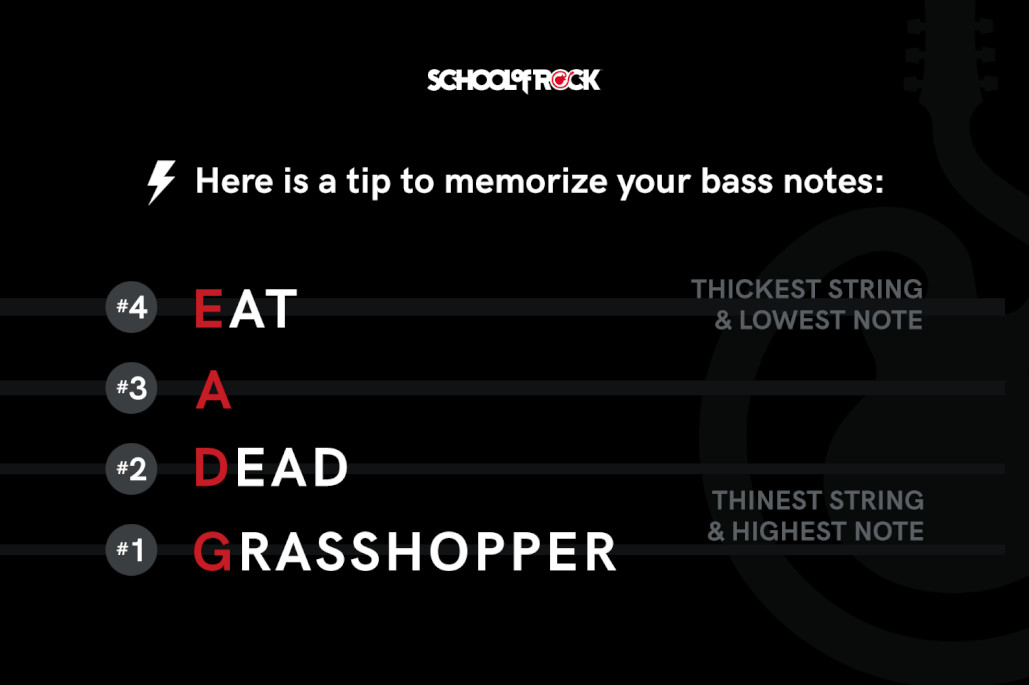When you’re just starting your bass guitar journey, one of the first and most crucial things to learn is the names of the strings. Understanding the names of your bass strings is fundamental, just like knowing the alphabet before you start writing words. It’s impossible to get that rich, resonant bass sound you’re aiming for if your instrument isn’t tuned correctly, and knowing the string names is the first step in achieving perfect pitch.
Regular practice is key to mastering any instrument, and when your bass is properly tuned, practice becomes much more enjoyable and rewarding. Imagine trying to learn your favorite bass lines with strings that sound completely off – frustrating, right? Thankfully, tuning a bass guitar and understanding the names of its strings is now easier than ever, setting you up for a successful and fun learning experience.
Understanding the Basics: Bass Guitar String Names
Let’s dive into the essential parts of the bass guitar that relate to tuning. The tuning pegs, located on the headstock of your bass, are your tools for controlling the pitch of each string. By turning these pegs, you either tighten or loosen the strings, which directly changes the sound they produce. Tightening a string increases its pitch, making it sound higher, while loosening it lowers the pitch, making it sound deeper.
How Often Should You Check Your Bass Guitar String Tuning?
The best practice is to tune your bass every single time you pick it up to play. Don’t assume your bass will hold its tune perfectly between practice sessions. While basses are generally more stable than regular guitars in terms of tuning, it’s still essential to check before each playing session.
If something sounds off while you’re playing, or if your bass sounds out of sync when you play along with recordings, it’s definitely time to check your tuning. Knowing the standard names for bass guitar strings will help you quickly identify and correct any tuning issues.
 Image alt text: Video thumbnail showing a person tuning a bass guitar, emphasizing visual learning for bass string tuning.
Image alt text: Video thumbnail showing a person tuning a bass guitar, emphasizing visual learning for bass string tuning.
How to Tune Your Bass Guitar Strings
There are a couple of common methods for tuning your bass guitar strings, and both rely on knowing the names of those strings:
- Tuning by Ear Using Reference Notes: This method involves using a “reference note” from another instrument, a tuning fork, or a pitch pipe. You play the reference note and then adjust your bass string until it matches the pitch. This requires a good ear and some practice in pitch recognition.
- Using Electronic or Clip-On Tuners: Electronic tuners have become incredibly popular and user-friendly. Clip-on tuners, in particular, are a game-changer. They attach directly to your bass’s headstock and detect the vibrations of the strings. These tuners will clearly indicate if your bass guitar string notes are “flat” (too low), “sharp” (too high), or perfectly in tune.
Tuning Bass Guitar Strings with a Clip-On Tuner
Clip-on tuners have truly revolutionized how bass guitars are tuned. Unlike older electric tuners that required cables and plugging in, these convenient devices simply clip onto your headstock and sense the vibrations of each string. They provide immediate feedback, showing whether your bass guitar’s notes are too flat (low), too sharp (high), or right on pitch.
When choosing a tuner, especially for bass, make sure it can accurately detect the low E string, which is the lowest note on a standard 4-string bass. Some tuners can struggle with these lower frequencies. However, many affordable and accurate tuners are available, making tuning your bass strings a breeze. Many practice amps even come with built-in tuners for added convenience.
Tuning Your Bass Guitar Strings Without a Tuner
Even without a dedicated tuner, you have several options for tuning your bass guitar strings:
Using a Tuner App on Your Smartphone
Smartphone tuner apps are incredibly handy. Many are available for free and utilize your device’s microphone to detect the pitch of your strings. As you adjust the tuning peg for each bass string, the app’s display will guide you until you reach perfect tuning for that string. This is a readily accessible and often free method for ensuring your bass string names match their intended pitches.
Tuning Bass Strings Using Another Instrument as a Reference
You can also tune your bass guitar strings using a reference pitch from another instrument, like a piano, that you know is correctly tuned. This method is a bit more challenging as it requires you to tune “by ear.” You’ll need to listen carefully to the reference pitch, play the corresponding note on your bass, and compare the two.
Adjust your bass string’s tuning peg until the pitch matches the reference instrument. Once you have one string in tune using the reference pitch, you can tune the rest of your bass strings to each other. This involves playing a fretted note on a lower string and then tuning the next open string to match that note.
Bass Guitar String Tunings You Need to Know: Standard and Beyond
Standard Bass Guitar String Names and Tuning
 Bass guitar notes are E, A,D, and G
Bass guitar notes are E, A,D, and G
If you’re playing a standard bass guitar, you’ll notice it typically has 4 strings. The standard bass guitar tuning for a 4-string bass, and therefore the names of the strings from thickest to thinnest, lowest pitch to highest, are E, A, D, and G. This is the same tuning as the four lowest strings on a standard 6-string guitar, but an octave lower, giving the bass its deeper sound. Notice that bass strings are tuned in fourths, meaning the interval between each string is a fourth.
To help you remember the names of the standard bass guitar strings, you can use mnemonics, such as:
- Elephants
- And
- Donkeys
- Grow
Or, a slightly less conventional but memorable one:
- Eat
- Apples
- Daily
- Guys
 tip to memorize your bass notes Eat A Dead Grasshopper
tip to memorize your bass notes Eat A Dead Grasshopper
5-String Bass Guitar String Names and Tuning
5-string basses are increasingly popular, offering an extended lower range. The most common tuning for a 5-string bass adds a lower string, tuned to B, below the standard E string. So, the string names and tuning for a 5-string bass become B, E, A, D, G. Some 5-string basses are tuned with a high C string instead, resulting in E, A, D, G, C, but the low B configuration is far more prevalent. Like 4-string basses, 5-string basses maintain tuning in fourths.
6-String Bass Guitar String Names and Tuning
For bassists seeking an even wider tonal palette, 6-string basses are available. These instruments expand the range in both directions, adding both a low B string and a high C string. The string names for a 6-string bass, from lowest to highest, are B, E, A, D, G, C. This provides an incredibly versatile instrument capable of covering a vast range of musical styles.
Drop D Tuning for Bass Guitars and String Names
Drop tunings offer a way to get a heavier sound without adding extra strings. These tunings became particularly popular in the 1990s, especially in heavier genres of music. Drop tuning involves lowering the pitch of your lowest string, typically by a whole step (two frets).
What is Drop D Tuning and How Does it Affect String Names?
Drop D tuning is achieved by lowering the standard E string down a whole step to D. For a standard 4-string bass, this means only the name of the lowest string changes. Standard tuning EADG becomes Drop D tuning D, A, D, G. The D string then becomes a fifth below the next highest string (A string), creating a deeper, “heavier” sound, particularly useful in rock and metal music.
Tips for Drop D Tuning and Lower Tunings
Drop D tuning (D, A, D, G) is very common. However, some genres, particularly metal, take this further, tuning down even lower. Drop C tuning is C, G, C, F, and Drop B tuning is B, F#, B, E. In all these drop tunings, only the lowest string’s name and pitch are altered from standard tuning.
Drop D Tuners: Quick Changes
For musicians who need to switch between standard and drop tunings frequently during performances, Drop D tuners are incredibly useful. These devices allow you to instantly change the tuning of your E string to D and back again without needing to use an electronic tuner or retune manually.
Keeping Your Bass Guitar Strings in Tune Longer
Once you’ve tuned your bass guitar strings and know their names, you’ll want to keep them in tune for as long as possible. Here are three key tips:
- Change Your Strings Regularly: Bass strings, like all strings, lose their vibrancy and tuning stability over time. Change your bass strings when they start to sound dull or become difficult to keep in tune. When you put on new strings, remember to stretch them. You can do this by playing or gently pulling on them (carefully, not too hard, or they might break). Bass strings are generally heavier gauge than guitar strings and thus more stable, lasting longer. However, if you play frequently and want a bright sound, monthly changes might be needed. Many players find bass strings last several months before needing replacement.
- Keep Your Bass Strings Clean: To prolong the life and tone of your bass strings, always wash your hands before playing and wipe down your strings after each session. This removes oils and dirt that can dull the strings and cause corrosion.
- Protect Your Bass in Its Case: When you’re not playing, store your bass in its case or gig bag. This protects it from environmental factors like temperature and humidity fluctuations, which can significantly impact tuning stability. Avoid exposing your bass to extreme temperature changes or humidity levels.
Whether you prefer using an electronic tuner or tuning by ear, following these steps will help you keep your bass in tune, sounding great, and much more enjoyable to play. Knowing the names of your bass guitar strings is the foundation for all of this!
Ready to Rock? Take Bass Lessons with GuitarPlayers.net!
Now that you’ve got a solid understanding of bass guitar string names and tuning, you’re ready for the next exciting step: learning to play! Just like the legendary bassists who came before you, you can master this amazing instrument. GuitarPlayers.net offers a wide range of bass lessons designed for every level, from complete beginners to advanced players. Start your journey to becoming a skilled bassist and unleash your musical potential with guitarplayers.net today!

